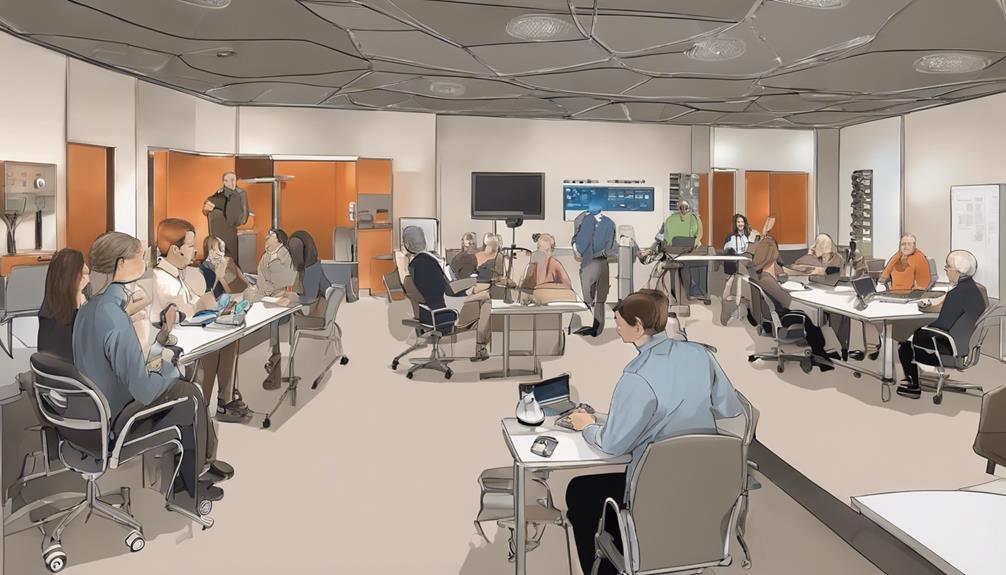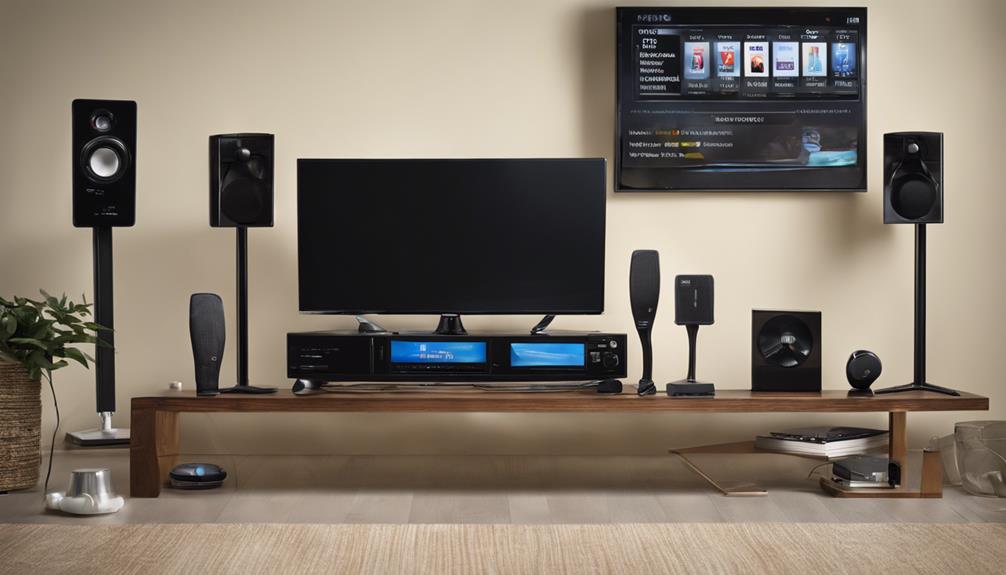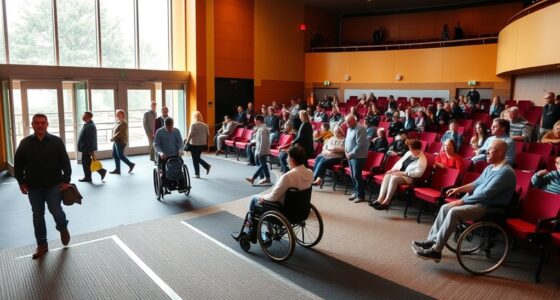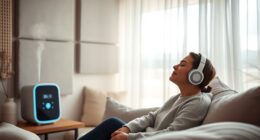Enhancing the TV viewing experience through the implementation of assistive listening devices can revolutionize how we enjoy our favorite shows and movies.
With the advancement of technology, the options for improving audio clarity and customization are vast.
From Bluetooth connectivity to specialized hearing loops, the possibilities are endless.
By exploring the benefits of various assistive listening devices and considering individual needs, finding the perfect solution to elevate your TV-watching experience becomes not just a choice but a necessity.
Key Takeaways
- Personalized sound settings revolutionize TV experience
- Improved audio clarity enhances immersion
- Tailored experiences cater to individual needs
- Inclusivity and comfort promote enjoyable TV watching
Benefits of Assistive Listening Devices
Assistive Listening Devices revolutionize the TV viewing experience by delivering unparalleled sound quality and personalized listening options. These devices cater to individuals with hearing difficulties, ensuring that TV dialogue is crystal clear and enjoyable.
By utilizing Bluetooth technology, ALDs wirelessly connect to TVs, providing a seamless listening experience without the hassle of cords. The noise reduction feature in these devices enhances focus by minimizing background distractions, allowing viewers to immerse themselves fully in the TV content.
ALDs offer adjustable settings, such as volume control and tone adjustments, to accommodate individual preferences and optimize the audio experience. Their compatibility with various audio sources guarantees a consistent and high-quality sound output, enhancing the overall TV watching experience.
Additionally, the portability of ALDs enables users to move around freely while staying connected to the audio, providing flexibility and convenience. Overall, the benefits of Assistive Listening Devices significantly improve the television viewing experience for individuals with hearing impairments.
How ALDs Enhance TV Watching

Enhancing the television viewing experience, ALDs provide personalized sound settings and improved audio clarity for individuals with hearing difficulties. When it comes to enhancing TV watching, ALDs offer a tailored experience through various devices:
- TV Streamers: These devices wirelessly transmit audio from the TV to compatible hearing aids or headphones, ensuring a direct and clear sound without background noise.
- Wireless Headphones: By using wireless headphones, individuals can adjust the volume to their preference without disturbing others, enhancing the clarity of dialogues and sound effects.
- Captioning Devices: Captioning devices display text on the screen, aiding those with hearing loss to follow the dialogue accurately and enjoy the content fully.
- Personal Amplifiers: These devices amplify the sound around the individual, providing a clearer audio experience without increasing the volume for others.
ALDs not only improve audio clarity but also promote inclusivity by offering a personalized and comfortable TV-watching experience for individuals with varying degrees of hearing loss.
Types of ALDs for TV
When considering the different types of ALDs for TV, users can choose from a variety of devices tailored to their specific hearing needs and preferences. These aids offer enhanced sound quality and customization options to improve the experience of watching television shows and movies. Here are some common types of ALDs for TV:
| ALD Type | Description |
|---|---|
| TV Streamers | Directly transmit audio from the TV to hearing aids, providing clear sound without interference from background noise. |
| Wireless Headphones | Offer an immersive TV-watching experience by eliminating background noise and providing customizable settings. |
| Captioning Devices | Display subtitles on the screen for improved understanding of dialogue and content while watching TV. |
| Personal Amplifiers | Amplify TV audio for individuals with hearing loss, enhancing the overall viewing experience. |
Each of these devices utilizes advanced technology like Bluetooth to deliver improved sound quality and customizable settings, catering to the specific needs of users, especially in noisy environments.
Choosing the Right ALD

In selecting the appropriate ALD for television use, we prioritize considerations such as the degree of hearing loss and the comfort and adjustability of the device. When choosing the right ALD, it's essential to take into account specific needs and preferences to ensure a tailored experience. To enhance your TV viewing, here are key factors to consider:
- Degree of Hearing Loss: Ensure the ALD is suitable for your level of hearing impairment, whether mild, moderate, or severe.
- Adjustable Sound Settings: Look for devices that allow you to customize the sound output to match your preferences and hearing requirements.
- Bluetooth Connectivity: Opt for ALDs with Bluetooth capabilities for seamless integration with your TV and other devices, providing flexibility and convenience.
- Noise Reduction Technology: Consider ALDs equipped with noise-cancellation features to improve sound clarity and minimize background distractions.
Wireless Headphones for TV
When considering wireless headphones for TV, we prioritize sound clarity, ensuring every word is crystal clear.
Comfort during extended viewing sessions is paramount, guaranteeing a pleasant experience.
Connectivity options for TV offer flexibility and ease of use for all users.
Sound Clarity With Headphones
Enhancing the television viewing experience, wireless headphones for TV provide personalized audio settings for improved sound clarity and immersive entertainment. These headphones connect wirelessly to the TV, eliminating background noise and offering a clear sound experience.
They incorporate noise cancellation technology to enhance dialogue clarity, making them ideal for individuals with hearing loss. With adjustable settings catering to individual preferences, wireless headphones ensure a comfortable and immersive TV viewing experience.
The portable design and wireless connectivity allow for freedom of movement, enabling users to enjoy TV shows and movies without being tethered to a specific spot.
Comfort for Long Viewing
Experiencing extended comfort during prolonged TV viewing sessions is facilitated by wireless headphones designed for optimal convenience. These wireless headphones offer a personalized audio experience through adjustable settings catering to individual preferences.
By connecting wirelessly to the TV, they effectively eliminate background noise, enhancing sound clarity. The incorporation of noise cancellation features in wireless headphones further filters out distractions, resulting in an immersive TV experience.
Additionally, users can relish the freedom of movement while watching TV, thanks to the wireless design of these headphones. This freedom ensures a comfortable viewing experience without being tethered by cords, allowing individuals to enjoy their favorite shows or movies with ease.
Connectivity Options for TV
To explore the connectivity options for TV, let's delve into the seamless integration of wireless headphones specifically designed for enhancing the audio experience during viewing sessions.
Wireless headphones for TV offer personalized audio streaming directly to the ears, eliminating background noise for a clear and immersive TV-watching experience. These headphones provide noise cancellation features and adjustable settings for comfort, all while connecting wirelessly to the TV, enhancing convenience.
Enjoy crystal clear sound quality and customizable options with wireless headphones for TV, making your viewing experience truly immersive and tailored to your preferences.
With these devices, you can immerse yourself in the audio of your favorite shows without distractions, ensuring a more enjoyable and personalized entertainment experience.
Personal Sound Amplifiers Overview

Personal sound amplifiers offer a cost-effective solution for individuals with mild to moderate hearing loss, providing enhanced audio clarity for TV viewing. These small devices amplify sound, improving dialogue clarity and overall sound quality while watching TV.
Unlike traditional hearing aids, personal sound amplifiers are designed specifically to enhance the TV watching experience. They're portable, easy to use, and don't require extensive hearing assistance setup, making them convenient for daily use at home.
Loop Systems for TV

Loop systems for TV provide a magnetic field that enhances audio clarity for individuals with hearing aids. These systems work seamlessly with T-coil equipped hearing aids, creating a direct audio transmission for clear TV sound. Here's why loop systems are beneficial for personalized TV-watching:
- Compatibility: Loop systems are designed to be compatible with T-coil equipped hearing aids, ensuring a smooth and efficient audio experience.
- Enhanced Dialogue Clarity: By providing direct audio to the hearing aids, loop systems enhance dialogue clarity, making it easier for individuals to follow conversations in TV shows.
- Reduced Background Noise: Loop systems help in reducing background noise, allowing users to focus on the program's audio without distractions.
- Personalized TV-Watching: These systems offer a personalized TV-watching experience at home, catering to the specific audio needs of individuals with hearing loss.
Degree of Hearing Loss Consideration

When selecting assistive listening devices for TV, it's crucial to consider the degree of hearing loss for optimal performance. By understanding the severity of the hearing impairment, one can match the device features to the individual's needs.
Factors such as hearing aid compatibility, sound amplification options, and customizable volume settings play a significant role in enhancing the TV viewing experience.
Hearing Aid Compatibility
Considering the degree of hearing loss is crucial when assessing the compatibility of assistive listening devices for TV. To ensure optimal hearing aid compatibility, it's essential to match device features to the individual's specific needs and hearing loss profile.
Look for devices with adjustable settings that cater to the degree of hearing loss, providing customizable features tailored to enhance the TV experience. Connectivity options play a significant role in ensuring seamless integration with hearing aids and other devices, offering a personalized and immersive audio experience.
When selecting a device, prioritize compatibility with the individual's hearing aids and the customizable features that can adapt to their unique hearing requirements.
Sound Amplification Options
To optimize sound amplification options for TV viewing based on the degree of hearing loss, it is essential to select devices that cater to the individual's specific needs and ensure maximum clarity and enjoyment. Modern hearing aids and assistive listening devices have revolutionized the way individuals with hearing impairments experience TV. For mild to moderate hearing loss, personal sound amplifiers can enhance the audio. Severe hearing loss may necessitate loop systems that create a magnetic field for clearer sound transmission. By tailoring the amplification device to the severity of the hearing loss, viewers can adjust the volume to their preference, leading to an immersive experience. Below is a table highlighting the benefits of using hearing amplification devices for TV:
| Degree of Hearing Loss | Recommended Device | Benefits |
|---|---|---|
| Mild to Moderate | Personal Sound Amplifiers | Enhanced audio for clearer sound |
| Severe | Loop Systems | Clearer sound transmission |
Customizable Volume Settings
Customizable volume settings on assistive listening devices play a crucial role in tailoring the audio experience to meet the specific needs of individuals with varying degrees of hearing loss. When considering the degree of hearing loss, adjusting volume levels becomes essential for a comfortable TV-watching experience. Here's why:
- Individuals with mild hearing loss may require different volume settings compared to those with moderate or severe hearing loss.
- The ability to adjust volume levels ensures a personalized experience for users with varying levels of hearing impairment.
- Customizable volume settings help find the optimal sound level, enhancing dialogue clarity and overall audio quality.
- Setting volume levels based on the degree of hearing loss significantly improves the effectiveness of assistive listening devices during TV watching.
Comfort and Connectivity Factors

When selecting an assistive listening device for TV, prioritizing comfort and connectivity features is essential for prolonged usage and optimal performance. Comfort plays a crucial role in the selection process, ensuring that the device can be worn for extended periods without causing discomfort. Adjustable features like volume control and fit contribute significantly to the overall comfort level of the assistive device, allowing users to customize their experience based on their specific hearing needs. Additionally, considering the design and weight of the device is important to guarantee that it remains comfortable during extended TV viewing sessions.
In terms of connectivity, options such as Bluetooth capabilities or wireless connectivity can enhance the convenience of using the assistive listening device with the TV. Ensuring compatibility with various TV models and audio sources is also essential for seamless integration and optimal performance. By prioritizing comfort and connectivity features, users can enjoy TV with enhanced audio quality while minimizing background noise and focusing on the content they're watching.
Frequently Asked Questions
What Technology Helps People With Hearing Impairments Enjoy Television?
When it comes to technology aiding those with hearing impairments in enjoying television, Bluetooth connectivity in newer hearing aids and Bluetooth streaming adapters for Smart TVs play a significant role. These devices facilitate seamless audio streaming directly to the user's ears.
Additionally, assistive listening devices such as TV streamers, wireless headphones, and captioning devices enhance the TV-watching experience by providing clearer and more personalized audio to accommodate varying levels of hearing loss.
How Can I Amplify My TV Sound for Hard of Hearing?
We can amplify TV sound for the hard of hearing by using TV assistive devices like TV streamers and wireless headphones. These devices connect directly to the TV, providing high-quality sound that enhances clarity and volume.
They're particularly beneficial for individuals with hearing loss, ensuring a comfortable TV-watching experience. By using TV assistive devices, we can make TV programs more accessible and enjoyable for those who are hard of hearing.
What Are the Benefits of Assistive Listening Devices?
Benefits of assistive listening devices include:
- Improved sound quality
- Personalized listening experiences
- Noise reduction
- Portability
- Compatibility with various audio sources
These devices enhance TV viewing by:
- Offering clear and natural audio
- Providing customizable options
- Focused sound
- Freedom of movement
- Seamless integration with TVs and other devices
They elevate the audio experience for individuals with hearing difficulties, ensuring an enjoyable and immersive TV experience.
What Is the Aid for Listening to Tv?
We use assistive listening devices to improve sound quality and clarity when watching TV. These devices, such as wireless headphones or loop systems, offer personalized listening experiences with adjustable settings and noise reduction technology.
They connect directly to the TV, providing clear audio without background noise. Individuals can select the best device based on their hearing loss degree and personal preferences for comfortable TV viewing.
Conclusion
In conclusion, utilizing assistive listening devices can truly transform the TV viewing experience for individuals with hearing impairments. By incorporating Bluetooth technology, personalized volume control, and improved sound clarity, watching TV becomes a more enjoyable and immersive experience.
Choosing the right ALD based on factors such as degree of hearing loss and comfort can make a significant difference in enhancing audio quality. Imagine being able to hear every word clearly and feel fully engaged in your favorite TV shows – that's the power of assistive listening devices.











